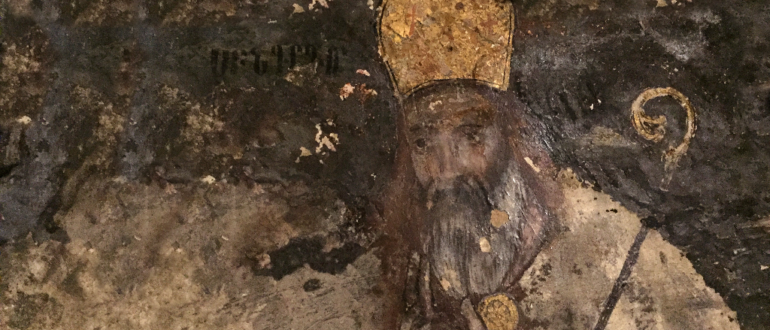St. Gregory the Enlightener
St. Gregory, whose birth name was Suren, was the son of Prince Anag, who was sent to Armenia by the Sasanian, King of Kings of Iran, to assassinate King Khosrov of Armenia and facilitate the Iranian occupation of that country. Our ancestors were convinced that St. Gregory had received the grace of the Apostle because he was conceived near the grave of the Holy Apostle Thaddeus, the first enlightener of Armenia.
Anag and his brother succeeded in murdering King Khosrov in the city of Vagharshabad in about A.D. 240. They fled in haste, but the Armenian contingents stopped them near the city of Ardashad and slew Anag’s entire family. Only two infants, Gregory and his brother, were saved from the massacre. Their Christian nurse Sophia took the boys to Caesarea to Eski Shehir, southwest of modern Kayseri in Anatolian Turkey.
In Caesarea, Gregory was christened and brought up as a Christian. When Gregory was of age, he married a Christian girl named Mariam, daughter of David. Gregory and Mariam had two sons, Vrtanes and Arisdages. Three years after Arisdages’ birth, the couple willingly decided to part from each other. The elder child, Vrtanes, was placed in the care of his nurse and Mariam took the younger Arisdages with her as she withdrew to a convent. The custom of Christian couples dissolving their marriage ties to seek monastic life was common in the 4th century.
Gregory himself headed for Armenia to serve as King Drtad’s secretary. At the time of King Khosrov’s assassination, Drtad, the king’s son and heir to the throne, was still an infant. Drtad was saved and taken to Roman territory. Also saved was Drtad’s sister Khosrovitukhd. Drtad was raised under Roman protection and later joined the Roman legions. He achieved fame as a valiant soldier and the Romans recognized Drtad as king of Armenia and helped him to reclaim his ancestral throne in 274. While eastern Armenia was still under Iranian sovereignty, Drtad ruled for two years before he was ousted from his kingdom.
It was at that time (between 274 and 276) that Gregory, who had found out about his father’s vile deed, decided entered the service of Drtad under a false identity to make amends. He pursued his duties faithfully over a period of several years. Drtad, once again with Roman help, was permanently established on the throne of western (Roman) Armenia in 287. Soon after, the relationship between him and Gregory deteriorated. The ceremony of thanksgiving and sacrifice to the pagan goddess Anahid in the village of Yeres (province of Yegeghik in western Armenia), following Drtad’s great victory over the Persians. When Gregory refused to offer wreaths and thick branches of trees to the altar of the goddess at the king’s request, he was incarcerated.
King Drtad ordered him to be subjected to twelve different kinds of torture at a site located to the immediate south of Erez, the present-day city of Erzinjan in Turkey. A monastery dedicated to the passion of St. Gregory was erected at this site.
After withstanding numerous incidents of torture, St. Gregory was transferred to the city of Ardashad and thrown into a bottomless pit reserved for notorious criminals condemned to death and located in the citadel of that town.
It is reported that Gregory survived in the pit for thirteen years. Gregory’s survival was made possible through the charity of a widow who lived in the fortress where the dungeon was located. She had received a command in a dream to prepare a loaf of bread every day and throw it down into the pit. That served as the source of Gregory’s sustenance for thirteen years. At the site of the bottomless pit, there is now a monastery called Khor Virabi vank (Monastery of Khor Virab, a place of pilgrimage facing Mount Ararat and almost on the border of present-day Armenia and Turkey).
His Sons and Grandsons
The Feast of St. Gregory the Illuminator’s Sons & Grandsons
The calendar of the Armenian Church singles out four members of St. Gregory’s family—his two sons, Sts. Arisdagés and Vrtanés, and his grandsons, Sts. Krikoris and Husig—and assigns them a special day of commemoration called “The Feast of the Sons and Grandsons of St. Gregory.”
The day of commemoration (according to the present calendar in force since 1774-75) falls on the Saturday before the Third Sunday of Transfiguration. Originally it was observed on the Tuesday following the Fifth Sunday after Pentecost. The feast of the discovery of the relics of St. Krikoris, however, is observed separately on the Monday following the Fifth Sunday of the Exaltation. Excluded from this group of saints are the rest of the members of the Gregorid family, namely Sts. Nersés the Great, Sahag the Parthian, Vartan and his daughter Shushanig. The latter are commemorated on different days during the year.

